We continue our analysis of costuming on Game of Thrones, picking up on the heels of the last analytical piece, A Song of Pins and Needles – Beauty Battles Believability in Game of Thrones Costume Design for Margaery Tyrell Part 1. As we move forward looking at Margaery Tyrell’s (hereinafter “Marg’s”) outfits, keep these important definitions in mind:
Watsonian – The in-universe explanation, view, or analysis of an aspect of media
Doylist – The real-life explanation, view, or analysis of an aspect of media
These terms will be used throughout this analysis. A more detailed explanation of them can be found in Part 1.
In the last piece, we looked at Marg’s early costume issues, including her infamous funnel dress and her variety of sexy dresses. Now we turn to her two final iconic looks: Marg’s wedding dress for her marriage to Joffrey, and her new set of pilgrim dresses introduced in season 6.
And while it won’t be discussed in great detail here, shout-out to whoever designed the gold dress that Marg wears in this scene with Tommen. It is not only beautiful but also a logical progression into a more regal style for Marg based on her original style. It’s a dress I’d love to own, which might betray its anachronistic touch – but I’m willing to ignore that in this case so I can have at least one ray of sunshine in this cloudy landscape of strange fashion choices and illogical accessories.
So let’s jump on in to another round of A Song of Pins and Needles!
Marg Went to Kleinfeld!
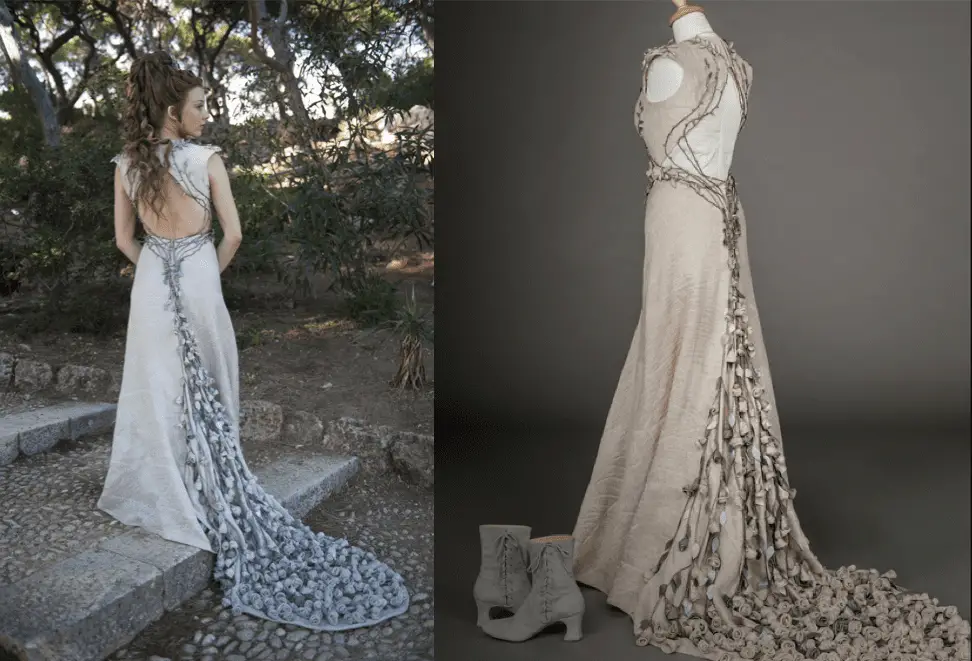
Marg’s wedding dress from the Purple Wedding – the second wedding dress we ever see on screen, after Sansa’s (Talisa doesn’t have a special dress, she’s too busy being Empowered™) – presents a plethora of problems for an audience with any genuine concern for consistency or world-building. To break it down, let’s start first with a look at the dress itself as a garment.
I always found Marg’s wedding dress quite beautiful. I like the detail of the waterfall roses in the back, and I appreciate the work it took to not only make those roses (there must be hundreds) but also to embroider the back and bodice of the gown. I also like the detail of the leather thorns. I can see the connection between the physical thorns on the garment and Marg’s similarities to her grandmother, the Queen of Thorns. The design is a subtle hint that Marg is not as sweet as she appears, which is at least interesting.
I can also appreciate that this was likely a very difficult dress to construct. You can see the smoothness of the bodice and shoulder-area, which definitely required expert sewing skillz.
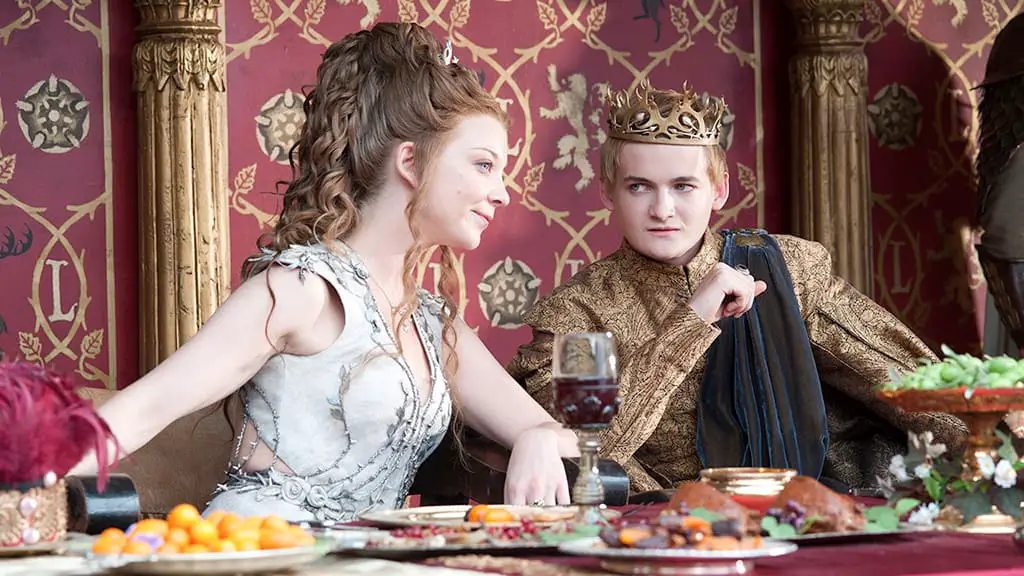
There are a few minor floofs – the back closure doesn’t exactly lie flat, and the length of the front of the skirt is questionable. Overall, the dress itself is an acceptable garment, and whether a viewer likes it void of any Game of Thrones (“GoT”) context is just a matter of opinion.
My opinion? I want this dress! I’d wear this to my own wedding in a heartbeat, albeit with different shoes and no cage hidden in my hair. But the fact that I, a modern-day woman in her twenties, want to wear this dress, and that it would be perfectly acceptable for me to wear it to my own wedding, reveals the innate problem with this design: it is anachronistic.
The gown has a modern silhouette, basically an A-line skirt with a short train, with a bodice that clings to the body. Now, this is a simple design, and we can’t claim the A-line skirt belongs to the modern world by any means. Indeed, there are a number of A-line dresses within the GoT universe that are not anachronistic in any way. The issue here comes from a modern fashion trend.
The dress has a modern look largely because of the cut-outs at the waist and large exposed back. Skin exposure like this was not common in the medieval era and, entirely avoiding the issue of comparing a fantasy world to real-life history, this style is absent elsewhere in Westeros. The closest thing we see is Marg’s own selection of sexy dresses. But the previous wedding dress we saw did not resemble Marg’s at all, nor do later wedding dresses that appear in the show. However, cut-outs and exposed backs are hugely popular in modern wedding dresses. Wedding designers use exposed backs to create drama. Marg’s dress looks much more modern, and therefore appears out-of-place in the GoT setting.
The anachronistic feel permeates both the Watsonian and Doylist analyses of this costume. The in-verse understanding and explanation of this dress starts on a shaky foundation because of that anachronism, while the Doylist may provide yet another example of the show’s general disregard for the source material. At this point, having reviewed multiple female costumes thus far in this series, we should be able to begin to piece together patterns (no pun intended) when it comes to design in the story. With Marg, it appears the pattern is that perceived beauty will always trump believability. We can discern this from the absent or tortured explanation of Marg’s dresses provided by the designers, along with the conflicting world-building that makes her outfit choices unlikely or impossible.
Watsonian: Marg is Not Like Other Girls
Watsonian analysis focuses on the in-verse explanation of why something exists. So, the audience must imagine the process it took to commission, design, and create a wedding dress for the future queen at her big fat royal wedding. First, consider the purpose of having such a large wedding and the role of a young queen.
Royalty of medieval times functioned a lot like politicians today. They had some power to enact laws and control the kingdom, but a large part of a royal’s job is to be a symbol of the monarchy that inspires and influences her people. Two modern-day examples are Michelle Obama and Kate Middleton. As First Lady, almost all of Michelle Obama’s power came from influencing the public through good works and appearances done in the public eye. She set an example for everyone to look up to, solidifying her family’s position as the First Family with political clout. Kate Middleton is in a similar position, albeit a more permanent one, and also does good works in the public eye to represent the kindness and strength of the monarchy. Politics is largely about appearance because a politician sets an example for her people.
The kicker is that we actually see this played out in the show, so at some point in time the writers were aware of it. Early on in Marg’s plot, just after she arrives in King’s Landing, she personally visits an orphanage to talk (read: spread propaganda) to the children about their fathers’ bravery on the Blackwater. She knows the small folk will see her there, and that act of kindness will influence them along with making them adore her. Marg even gets the smallfolk to like Joffrey for a time, as shown when the two appear on the steps outside Baelor’s Sept together and the crowd cheers. Season three Marg seemed to understand her role as an example to the people and a representation of the new monarchy.
So where does the wedding dress from Kleinfeld come in? Here’s the basic problem with the dress (disregarding the anachronism): it’s too plain. We are talking about the most extravagant wedding of the century here! They had seventy-seven courses planned for the feast! Thousands of people attended, and all the smallfolk of King’s Landing cared about and paid attention to this ceremony. Think about how batshit people went over Kate Middleton’s wedding dress, or even Princess Diana’s dress back in the day – and those dresses were fashionably on-point (for their era) and made of expensive fabrics, like silk. Marg is rolling around in a linen-silk blend cut in an unknown, not-popular style. This dress should have been extravagant.
Even Sansa’s wedding dress was more queenly than Marg’s. Take a look at the hand-beaded embroidery happening here, and the beautiful brocade fabric!
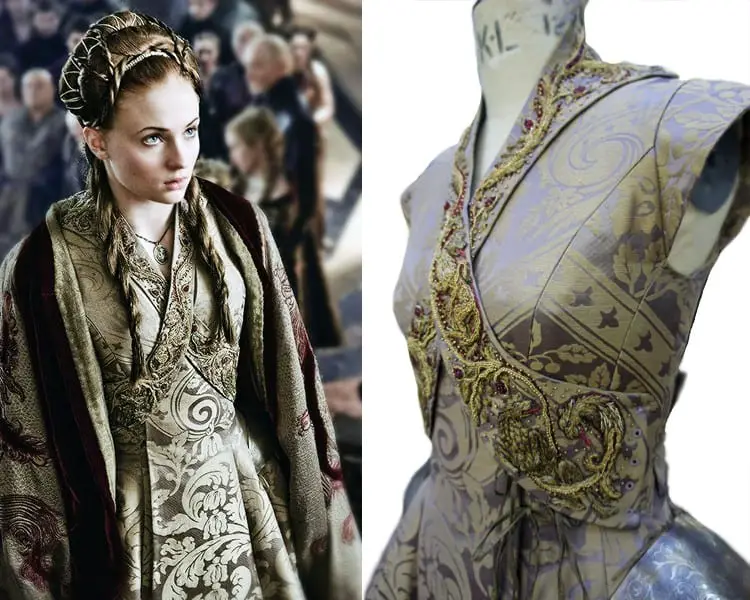
The only Watsonian explanation is that Marg completely dispensed with her known purpose at the wedding – to look like the new queen for the audience – and decided to YOLO in a dress I guess she liked? I don’t think it’s possible for Marg, having acted how she did and having been present for Sansa’s marriage, to have thought this dress was appropriately queenly. And if this was meant to be another “experiment” or a statement piece, it was executed at a HIGHLY inappropriate time (a royal wedding?!) and it clearly didn’t make an impact, as we never see any dresses like it again.
Finally, while the Watsonian explanation is lacking (I really can’t think of any other reason that makes any sense), I do like to imagine that someone in-verse put thorns on this dress in a symbolic way. It could have been the city’s most meta seamstress, maybe the same that made the Bjork dress. But my personal headcannon is that Marg herself added the thorns, giggling as she picked them out from the bead section at A.C. Moore, saying to Megga, “Now I’ll really be a thorn in Cersei’s side!”

Doylist: Just Look at the Flowers
Based on the Watsonian analysis, I think it’s a somewhat fruitless effort to compare the show’s wedding dress with the description from the books. It’s clear to me that Michelle Clapton’s driving motivation in designing this garment was just for it to be a beautiful wedding dress. The only tie it has to the GoT universe at all is the presence of roses as the symbol of House Tyrell, and otherwise the style does not make any sense in the context. But for consistency sake, let’s look at the book description.
“The bride was lovely in ivory silk and Myrish lace, her skirts decorated with floral patterns picked out in seed pearls. As Renly’s widow, she might have worn the Baratheon colors, gold and black, yet she came to them a Tyrell, in a maiden’s cloak made of a hundred cloth-of-gold roses sewn to green velvet.” – A Storm of Swords
Book!Margaery clearly chose her wedding dress with care, making sure to appear in the colors of her house with not a hint of her former marriage. This is a major part of Margaery’s ability to marry Joffrey, and remains part of her public persona in the books when she marries Tommen – that she is a maiden according to Westerosi standards, and therefore able to marry royalty. This certainly could not have been the goal of show!Marg’s dress choice, since it is significantly more revealing than other dresses we have seen on screen.
In addition, the book version is clearly more exquisite. The fabrics themselves are of higher quality, specifically silk, a very rich fabric, and “Myrish lace”, which is made expensive by the fantasy universe since the lace comes from across the Narrow Sea. The image of the entire skirt being designed in seed pearls is spectacular – seed pearls are very small, and would require thousands to be sewn on individually to create a skirt-covering pattern. The hundreds of cloth-of-gold roses, too, would have to be individually hand-made and sewn onto a draping velvet cloak. Damn I wish there was a visual adaptation of this novel!

The decision to alter this design baffles me. If this were any other show, I might be able to explain away some of the issues. For instance, a floral design “picked out in seed pearls” may not show up well on screen, since seed pearls are like small beads. But then instead we got tiny chains and tiny thorns all gathered around the middle of the bodice, which also did not show up well on screen! And there are countless examples of hand-beading that must have taken hours that is barely visible. And then of course there’s the six hundred masks issue. If this were any other show, I might say that making hundreds of roses by hand to put on a costume would be too much labor, but then we literally get exactly that in a way that is less dramatic and less beautiful (and less symbolic, since gold is a Tyrell color and mottled grey is not).
There is no logical reason to change this design, which seems to be a running pattern for a lot of these costumes. Clapton basically made a sexier, more dramatic version of Marg’s earlier series of sexy dresses, lightened the color a bit and called it a wedding dress. We know this for a fact because she told us. When asked about her inspiration for the dress, Clapton said:
“Really just a play on her sigil and following the style that she has developed since her arrival at King’s Landing. It had to be very different from Cersei’s style and taste.” – Michele Clapton
We know the costume design wasn’t deeply thought-out here, based on Clapton’s own words. And at a certain point, that’s fine – sometimes a pretty dress is just a pretty dress. The impetus to make Marg’s style markedly different from Cersei’s probably comes from D&D, who set Marg up as the scheming sexual manipulator who must always be working to undermine poor put-upon Cersei.
It appears the design of this wedding dress is just another key-jingling moment for the show, getting the audience excited by making them look at the flowers on that gosh darn pretty dress! At the end of the day, there isn’t a complex Doylist explanation, and the whole thing comes up to a kawaii shrug.

It should be noted that I did got back and re-watch the crowd scenes of the Purple Wedding, and there are in fact extras wearing some of Marg’s series of sexy dresses with large cut-outs and exposed backs. This just begs the question yet again – what’s the temperature in King’s Landing??
The City’s Most Meta Metalworker
“The idea of the briar rose is continued into the crown where it wraps around the Baratheon antlers [Joffrey’s sigil]. This was to show her creeping influence, which is not lost on Cersei.” – Michele Clapton
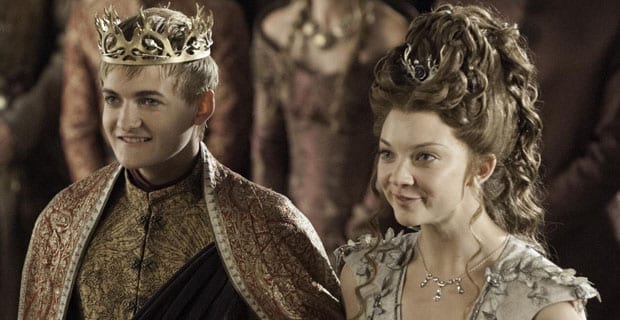
Both Joffrey’s and Marg’s crowns display this motif of rose vines intertwining with stag antlers. As Clapton explains above, the point is to show the “creeping influence” of the Tyrells over the Baratheons/Lannisters. When I first discovered this, I thought it was an interesting detail.
But then I thought: who made this??
Looking at the in-verse explanation, I must know what goldsmith made these two crowns. Did the goldsmith design the crowns himself? Did he sit there thinking, “Yes, I’ll express my concerns about the encroaching influence of the Tyrell family on our glorious monarchy by crafting briar roses creeping between the stag antlers, so everyone knows the king is truly under the control of these upjumped servants”? I assume by now Marg must be followed by a tail of meta designers who all attended the School of Taking-Things-From-the-Source-Material-Way-Too-Literally. Oh, and also one Bjork fan.
There’s also the option that the Tyrells designed these crowns themselves. I can imagine the Queen of Thorns sketching out a design and showing it to Marg, while Marg shows off the badass thorn beads she picked up from A.C. Moore earlier. Maybe the Tyrell ladies just have so much fun tormenting and scheming against poor Cersei they just couldn’t help but make the crowns symbolic of their attempt to take over the monarchy. Crowns worn at a wedding where they planned to assassinate the king. Yeah. Sounds right.
We know Marg couldn’t have designed the crowns alone. She’s just not that good a sketch artist.
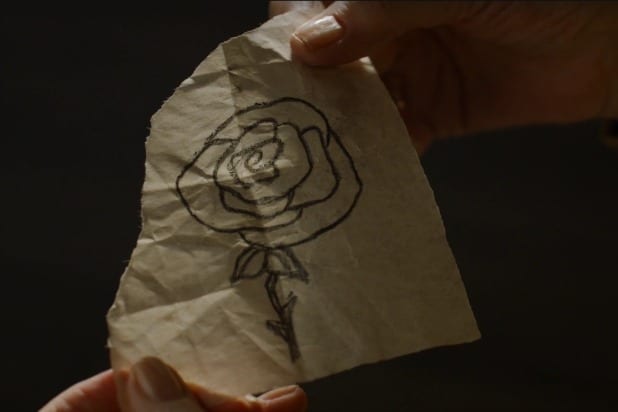
This is a fine example of a cool-sounding Doylist explanation, but a completely absent Watsonian one. The neat thing about symbolism and metaphor in literature is that it happens in a way that is natural in the story and isn’t terribly contrived. For example, in A Game of Thrones the book, the direwolf found dead with the stag’s antler in its throat is symbolic, foreshadowing with its symbolism the fall of House Stark at the hands of the Baratheons. But it also makes sense – stags and direwolves would fight in nature. It would be weird and contrived if, say, the characters had come across a large dead squid in the middle of the woods near Winterfell, its tentacles wrapped around a dead direwolf. The symbolism would be about the same, but the quality of the story and its believability is lost.
The crown idea was neat, but without a Watsonian reasoning, it is useless. Again we see a cool idea poorly executed, ending up in nothing useful.
Though I would love to meet the meta designers. Maybe they went to the art school near Talisa’s nursing college.
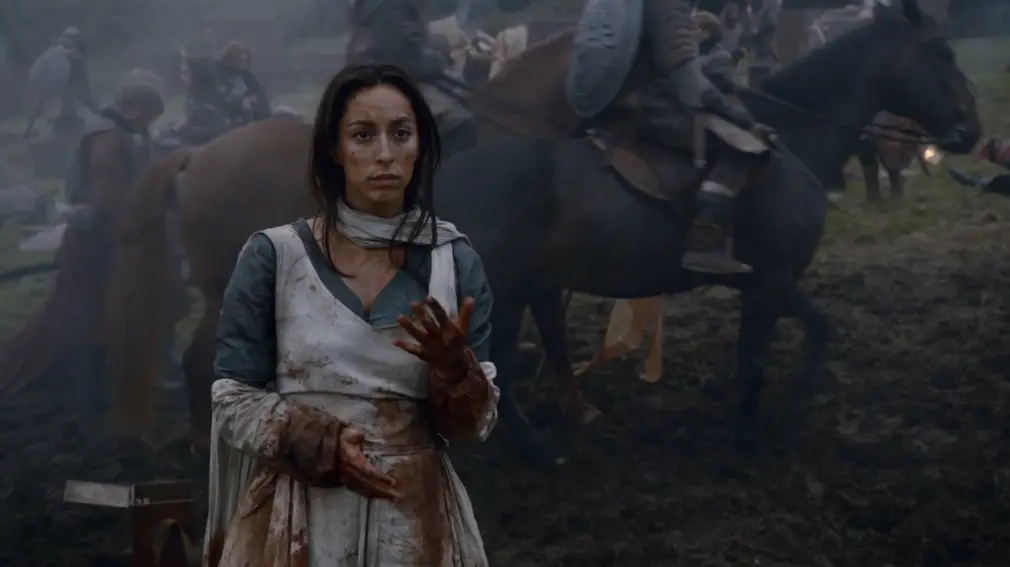
A Pilgrimage to Nowhere
Going into season six, GoT lost Michele Clapton (seven save us!) and gained a new lead designer, April Ferry. By this point the show’s writing and plot was completely off the rails, and it shows in the last few costumes designed for Marg. I’ll be referring to the last two outfits as the “Pilgrim dresses,” since they look like a fantasy version of what Pilgrims wore. Their creation undoubtedly stemmed from D&D’s disregard for and misunderstanding of the source material, so let’s recap a bit on that first.
The Faith of the Seven is NOT Christianity
Regardless of how D&D characterize it, the Faith of the Seven is not, in fact, a fantasy-version of Christianity. The Seven does not contemplate original sin. It does not hate gays. And it does not, importantly, abhor all sex. Instead, the Faith of the Seven as worshiped in Westeros is a projection of their toxically patriarchal society, and simultaneously reinforces that patriarchy through the seven “aspects” of the gods.
In brief, a toxic patriarchy is when certain roles are allowed for people based on their sex and social class, and that proscription is so strong that it limits people’s freedom and dictates their lives. Patriarchy brain, as discussed on the Unabashed Book Snobbery podcast in great detail, is when people living in such a society internalize those limitations in one way or another. The seven gods worshiped in Westeros are both a projection of patriarchy brain and a mode to reinforce the toxic patriarchy. We have:
The Warrior – Male, strong, meant to protect
The Maiden – Female, graceful, beautiful, virginal
The Smith – Male, strong, makes weapons and tools for men, the “hard worker”
The Mother – Female, loving, caring, meant to bear children, NOT virginal and embraced for not being virginal (sex is required for motherhood in Westeros)
The Father – Male, meant to protect, head of the household
The Crone – Female, old, useful for her wisdom and her ability to guide you
The Stranger – gender unknown, representation of death
Through these seven figures, this religion delegates everyone in Westeros to a specific archetype. Acceptable roles for women include maidenhood, motherhood, and old age; acceptable roles for men include knighthood, fatherhood, or as a skilled laborer; and both genders ultimately bow to death. The societal organization of people into simplified categories is a reflection and tool of a toxic patriarchy.
Note that, in this system, it is the characteristics of the aspect that applies to a person that matters when determining their social acceptability. A man can, for example, be a gay knight. Indeed, the seven most revered knights in the kingdom are specifically required to be chaste, limiting their ability to be fathers. Knighthood is premised on chivalry, not sexuality. An old woman can speak her mind more freely than a young woman, since she is used for her wisdom, not her virginity or reproductive capabilities. A married woman is encouraged to have sex with her husband to fulfill her role as a mother, while an unmarried maiden is pressured to remain abstinent. There isn’t a single set of rules applied to everyone across the board – the Faith of the Seven allows for different standards depending on the role a person fills in society.
Based on what we’re given from the show, it’s clear that D&D do not understand the Seven. We are shown a religion that abhors homosexuality, degrades women’s bodies, is against drinking alcohol, and, through the multitude of High Septon speeches, seems to have a concept of original sin. The show!faith also denigrates wealth and the material things that come with wealth, even though it exists in a feudal society built on stable class distinctions. Basically, show!faith is trying to be Christianity – or more accurately, a version of Christianity crafted without actually knowing much about it. D&D just picked the “Christian” issues that are hot-button in the modern world: gays and wealth, and a little bit of sex.
This fundamental misunderstanding of Westeros’s main religion seeps into the costume design for Marg in season six. I think it can go without saying that these dresses are ugly, only coming out as Marg’s second-worst outfits because of the Bjork dress (at least the pilgrim outfits aren’t cones). Some of the fabric is nice, but none of it is brocade, so I’m not about to fangirl over here.
Let’s take it one step at a time and consider the Watsonian explanation for Marg’s pilgrim dresses.
Watsonian: The Best Septa Cosplay in the Seven Kingdoms
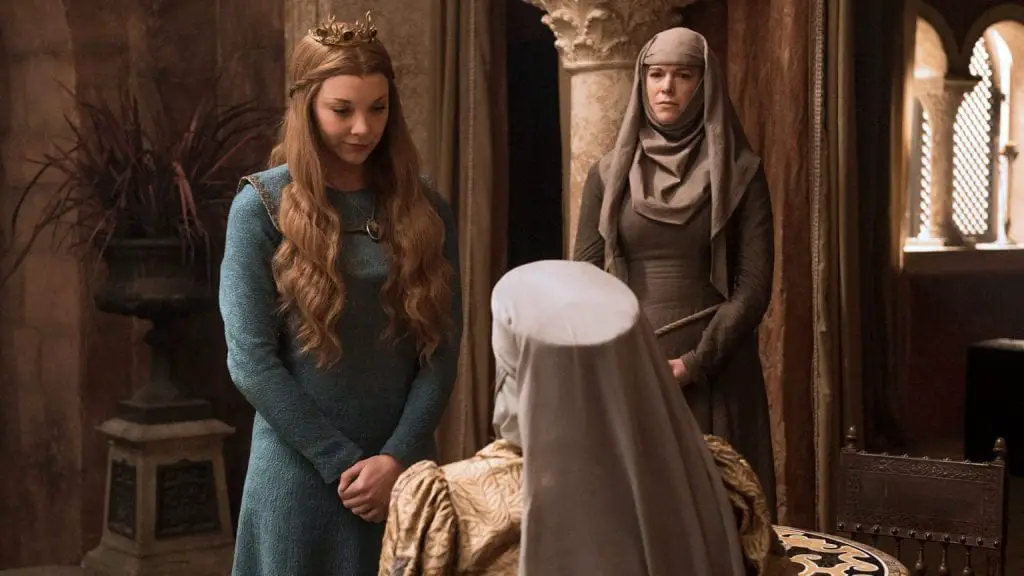
Marg comes to wear the first of the two mournful pilgrim dresses after she is released on holy bail from the Great Sept of Baelor, awaiting her trial for perjury. You read that sentence right – her trial for perjury. For the reigning queen to get out of jail pre-trial on her perjury charge, she must start dressing like a pilgrim and be followed around everywhere by a septa. The logic here seems to be that, to show she is pious and virtuous, she dresses in a less revealing way (in comparison to her series of sexy dresses). This might make sense if her charge had anything to do with her virtue or virginity, or if her sexual life was called into question at all, since that is high treason. But that is not the case – Marg is only charged with lying about her brother’s homosexuality, a charge that has nothing to do with her own sexuality. The new costume choice having a sexual origin doesn’t seem to hold water.
Additionally, the other character awaiting trial – a trial that is about adultery and fornication – is Cersei Lannister. Cersei is still given free reign to roam around the Red Keep in her regular old wrap dresses, no high-necklines to be seen. Indeed, the only other character wearing anything similar to Marg is the septa following her, loving known here at The Fandomentals as Septa Spoonella. Perhaps Marg’s goal is to appear pious by dressing like a septa. This is actually a compelling honeypot, especially given the High Sparrow’s multiple long monologues about how wealth is bad and shoes are awful.
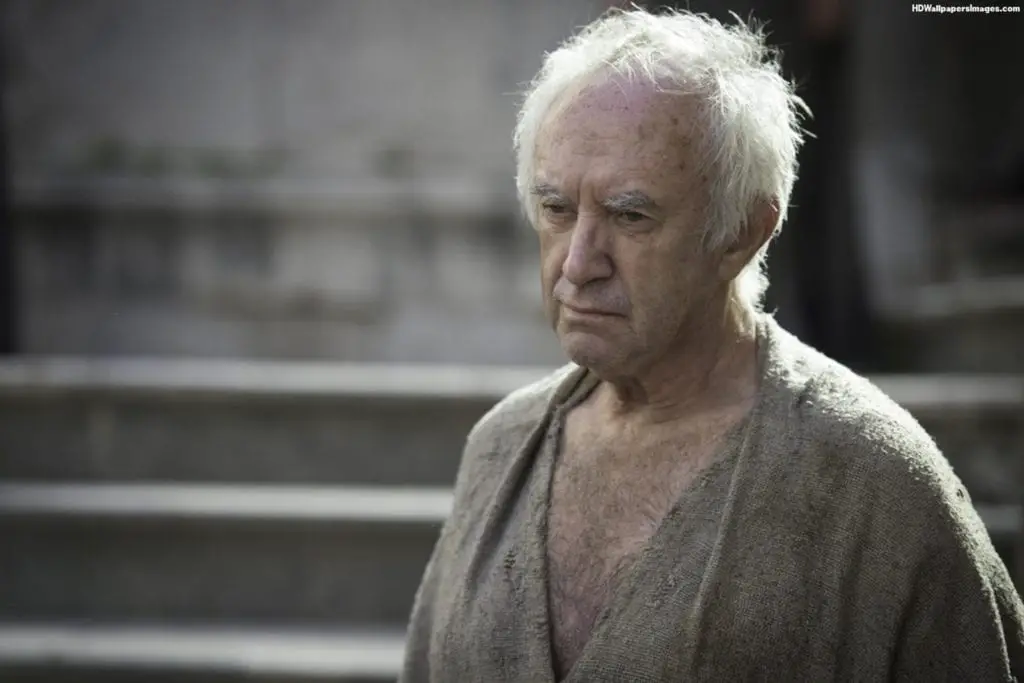
But this reasoning falls apart under scrutiny. If Marg wanted to dress like a septa to be pious, why not go full-out and get a septa costume? Marg is still wearing a dress made of nicer material than a septa. She’s still wearing her golden crown. She still has her hair perfectly done, probably by all of her serving ladies. She also still lives in the most important castle in the Seven Kingdoms. Even the pilgrim dress she wears to her trial, when she is in the Great Sept of Baelor, is way fancier than what a poor smallfolk could afford.
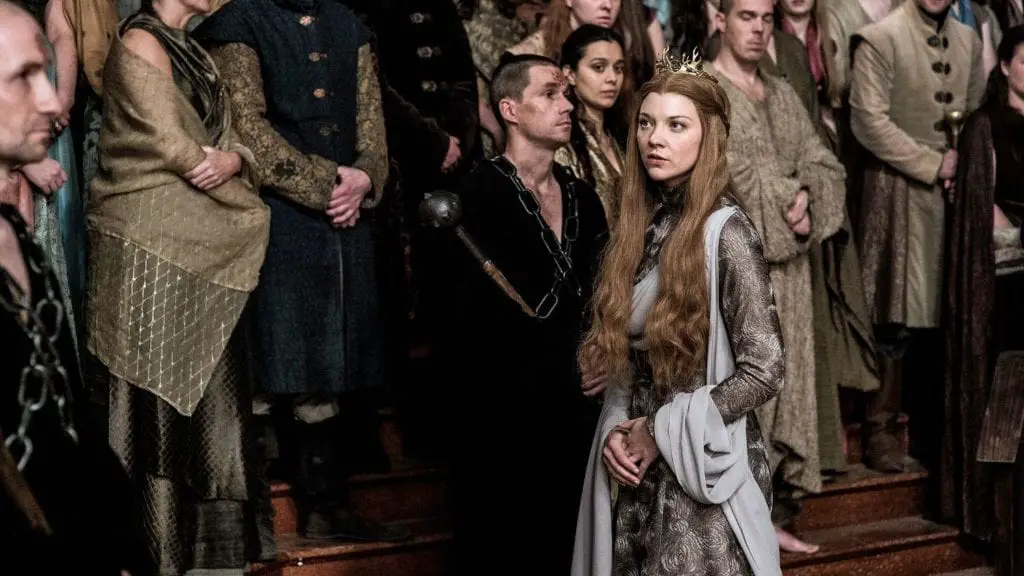
If the point is that simpleness is pious and wealth is sinful, Marg isn’t actually doing that good a job of putting on those pious airs. Maybe this is why the narrative decides to literally blow everyone up – because of their continuing sinful behavior!
Really, there is no good Watsonian explanation for Marg’s transformation into slightly fancy potato sacks. There is no precedent for it – the other queen awaiting trial isn’t wearing this shit. There’s no demand for it – Marg isn’t awaiting trial on anything sexy. Finally, there’s no need for it – the faith of the seven demands piety and purity, but not virginity for a queen who is proscribed in the role of a mother. Indeed, the High Sparrow himself tells Marg she needs to start gettin’ sexy with Tommen to make an heir!
With no stable explanation from the Watsonian perspective – even considering it from the warped view of the faith as Christianity that D&D employ – we should move on to the Doylist lens.
Doylist: D&D are So Brave™
I think the Doylist reasoning behind these costume designs is pretty clear: D&D think the faith of the seven is Christianity, and the costume designers went with that. The costume department was told “Marg needs to be more religious” and the reaction was to cover her body. There are two main problems here: the first is that this was the reaction at all; the second was that this reaction was employed in this fantasy setting.
First, the fact that the new design team, April & Co., or maybe D&D as well, decided the only way for Marg to show her newfound piety was to forcibly cover her is a problematic view of modern religious women. Piety and piousness are not innately connected to a woman’s sexuality, especially considering the hundreds of religions that exist and have existed in human history. The emphasis on sexuality is Abrahamic and western, and different for many other religions (*cough* including the Faith of the Seven *cough*). Additionally, plenty of religions include forms of covering for both men and women that are free and part of the faith. The fact of the matter is that religions, and forms of worship within those religions, are highly diverse. And the representation of that diversity in media reflects the intentions and opinions of the creators.
That this was the design route the show took reveals a western, negative outlook on religious covering, since Marg was forced into these outfits by the High Sparrow. The only other women dressed the same are the septas, who tortured multiple people and hold Marg hostage, and Cersei’s final outfit which she dons as she blows up the sept:
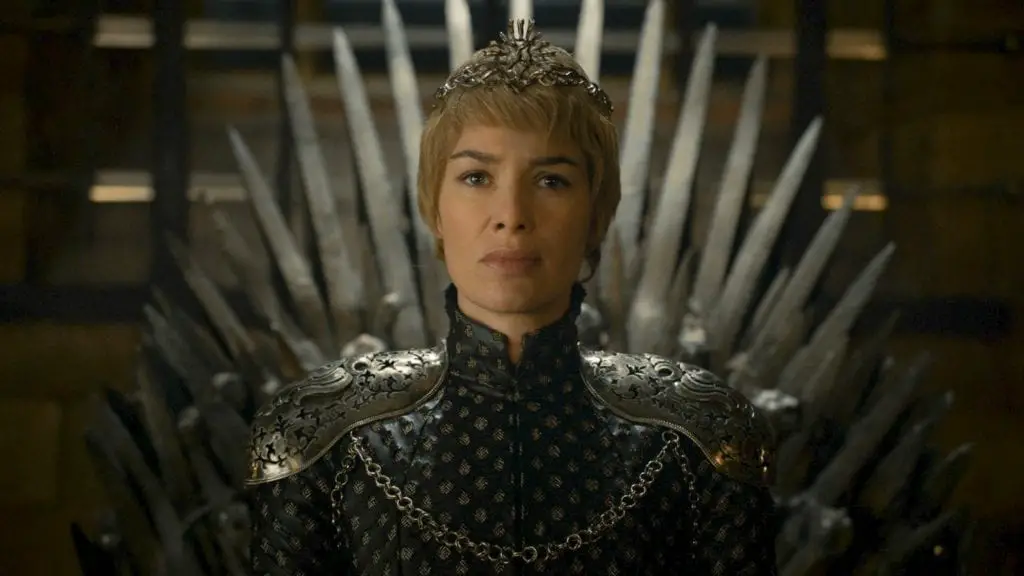
This has some unfortunate implications on the creator’s understanding and vision of religion, since the only similar designs adorn bad people. And we know this can’t be just a result of the confines of the universe – as discussed above, there is no Watsonian basis for this costume choice. This is another piece of the larger pattern that D&D, bleeding also into the costume department, have an agenda against portraying religion in a positive light.
The second issue, largely addressed above, is that the designers would bother trying to pass off these glorified potato sacks as costumes in this setting. Nothing about them makes any sense, and the deviation from the source material makes the show’s story worse, not better. The show dug itself into a massive grave by aging Tommen up so they could make exactly two sex jokes, even bringing down the costume department with it. This is a prime example of how the entire production is dependent on the tone set by D&D, and how the patterns of sexism, racism, homophobia, and others in their writing does permeate the whole show.
Conclusion: A Rose by Any Other Name..is probably dead from the sept explosion.
Coming to the end of our two-part analysis of Marg’s dresses from season two to season six, I think we can pick out some clear patterns. The overall pattern is that believability will always give way to perceived beauty. Marg’s “experiment” dress was high-fashion and couture in Clapton’s eyes; her series of sexy dresses were pretty and flowy, though out of place; her wedding dress was beautifully anachronistic; even her pilgrim dresses were made of nice fabrics and adorned with a golden crown, though she was trying to not be so darn rich!
Marg’s costumes also add to known patterns regarding storytelling devices. First, her costumes solidify her as the scheming, sexual manipulator of all men. Second, subtle details in her wedding dress and in the royal crowns place her purposefully opposite Cersei, adding to the “scheming” Marg does. Third, her pilgrim dresses compliment the woeful misunderstanding D&D have of the Faith of the Seven.
At the beginning of this two-part analysis, I emphasized that a good costume strikes the right balance between in-verse believability and real life expectations while also functioning in its role. Overall, I do believe Marg’s costumes functioned in their various roles as much as can be expected. My problems lie not with how the costumes function, but rather with the situations the costumes must function in. It’s not the designer’s problem that Marg is scripted as a sexual manipulator and that the costume design must follow that path. The intersection of writing and design makes it difficult to judge a costume as a stand-alone piece.
Through the art of costuming, the show emphasizes some of its greatest flaws: its internal inconsistency, its general illogic, and its plethora of meta-designers expressing their concerns about the monarchy through clever goldsmithing. This is simply not the world George R.R. Martin envisioned, and the costuming, while sometimes very impressive, is just not helping matters.
Let’s all take a moment and reflect on the one lovely costume in season six, which graced our screens for a few minutes.
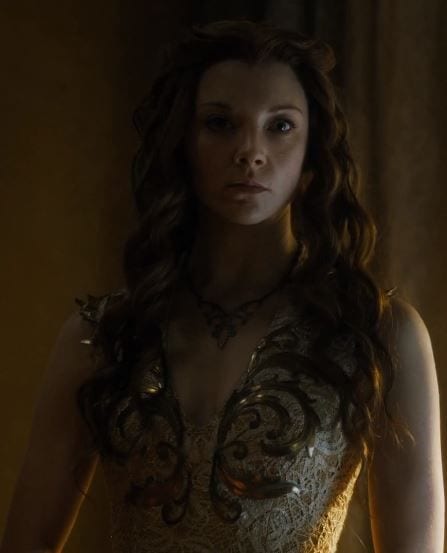
Moving on from our looks at Dany and Marg, we will move on next time to a close critical analysis of “Sansa Stark”.

